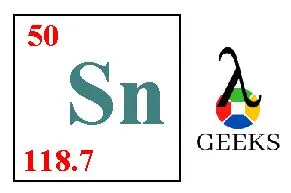Tin is a metal element present in the modern periodic table. Here, we are discussing the chemical properties of the tin element.
Tin is a soft solid metal element. It has greyish-white or silvery lustrous color. It comes under the base metals, which can easily extract. It is corrosion-resistant and cannot get easily oxidized. It can be used as a coating material and protect other metals from corrosion.
In this editorial, we are discussing the ionization energy, electronegativity, density, atomic weight, atomic number, symbol, block, and many more chemical properties of a tin element with some facts about it.
Tin symbol
The representation of elements of the periodic table within 2 to 3 alphabetic words is called a chemical symbol. Take a look below at the symbol of the Tin element.
The chemical symbol of Tin metal is ‘Sn .’Stannus is the Latin name of Tin, which has an Sn symbol.
Tin group in the periodic table
The chemical elements placed in vertical columns of the modern periodic table are called groups of that element. Let us see the group of Tin elements.
The Tin metal is placed in group 14 of the periodic table. It is also known as the 14thB group.

Tin period in the periodic table
The chemical elements placed in vertical columns of the modern periodic table are called groups of that element. Let us see the group of Tin elements.
The Tin metal is placed in period 5 of the periodic table.
Tin block in the periodic table
The periodic sections of elements with similar properties in the periodic table are known blocks of that element. Let us see the periodic block of the Tin element.
The Tin element belongs to the p-block elements of the periodic table.
Tin atomic number
The total number of protons in the nucleus of the atom of an element is known as its atomic number. Below see the atomic number of the Tin element.
The Tin metal has atomic number 50, i.e., 50 protons in its nucleus.
Tin Atomic Weight
The average weight of atoms in an element on the periodic table is known as its atomic weight. Let us see the atomic weight of the Tin metal.
The atomic weight of Tin metal is 118.710 u.
Tin Electronegativity, according to Pauling.
The electronegativity of an atom of an element is its capacity to attract electrons from neighboring atoms. See the electronegativity of Tin metal below.
The electronegativity of Tin metal is 1.96.
Tin atomic Density
The number of atoms of an element present per unit volume or cm3 or barn cm of a substance is called its atomic density. Look below for the atomic density of Tin metal.
The atomic density of the Tin metal is 7.287 g/cm3.
Tin melting point
The substance gets melts at a certain temperature or point is its melting point. Look at the melting point or temperature at which Tin get melts.
The melting point of the Tin metal is 231.982 °C (505.078 K, 449.47 °F).
Tin boiling point
The point or temperature at which the substance starts to boil is called its boiling point. Let us see the boiling point or temperature at which Tin gets boils.
The boiling point of the Tin metal is 2586 °C (2859 K, 4687°F).
Tin Vanderwaals radius
The distance between 2 atoms from their center of nuclei and held together by weak Vander Waals force of attraction is VanderWaals radius. See the VanderWaals radius of Tin.
The VanderWaals radius of Tin metal is 225 ppm.
Tin ionic/covalent radius
The covalent or ionic radius is the distance of the nucleus of the two opposite atoms or ions in an ionic compound. Let us see the ionic radius of Tin metal.
The covalent radius of Tin metals is 139 pm, and the ionic radius is 69 pm.
Tin isotopes
The same element atoms having the same number of protons but a different number of neutrons are the isotopes. Take a look at various isotopes of Tin metal.
Tin metal has the natural isotope 50Sn. The various isotopes of Tin metal are listed below-given the table.
| Isotopes of Sn | Characters |
| Tin – 100 (100Sn) | Most unstable Tin isotopes of Sn. |
| Tin – 132 (132Sn) | Most unstable radioactive Isotope of Sn. |
| Tin – 126 (126Sn) | Longest-live radioisotope of Sn. |
| Tin – 102 (102Sn) | Isotope with 4.5 seconds half-life period of Sn. |
| Tin – 107 (107Sn) | Isotope with 2.90 minutes half-life period of Sn. |
| Tin – 113 (113Sn) | Isotope with 3 days half-life period of Sn. |
| Tin – 121 (121Sn) | Isotope with 4 years half-life period of Sn. |
| Tin – 131 (131Sn) | Isotope with 5 seconds half-life period of Sn |
| Tin – 136 (136Sn) | Isotope with 0.25 seconds half-life period of Sn |
Tin electronic shell
The outer part of the atomic nucleus where the electrons get placed is called an electronic shell or electronic orbital. Let us see the electronic shell of Tin metal.
The electronic shell of Tin metal is 2, 8, 18, 18, 4.
Tin energy of first ionization
The essential amount of energy needed to cut off the high-energy electron of a neutral moiety is called 1st ionization energy. Look at the 1st ionization energy of Tin metal.
The first ionization energy of Tin metal is 708.581 kJ mol‑1.
Tin energy of second ionization
A certain amount of energy is required to detach the electron from the +1 ion of the moiety is called 2nd ionization energy. Look at the 2nd ionization energy of Tin metal.
The second ionization energy of Tin metal 1411.793 is kJ mol‑1.
Tin energy of third ionization
The essential amount of energy needed to cut off the high-energy electron of a neutral moiety is called 3rd ionization energy. Look at the 3rd ionization energy of Tin metal.
The third ionization energy of Tin metal is 2943.054 kJ mol‑1.
Tin oxidation states
The tendency of an atom to gain or lose electrons in bond formation and have a positive or negative charge is called the oxidation state. See the oxidation number of Tin.
The oxidation states of Tin metal are +4, +3, +2, 1, −1, −2, −3, −4, etc.
Tin electron configurations
The arrangement of electrons in the orbital or shell of atoms in some specific sequential form is an electronic configuration. See the electronic configuration of Tin metal.
The electronic configuration of Tin metal is:
- 1s 22s 22p 63s 23p 64s 23d 104p 65s 24d 105p 2 or
- [Kr] 4d105s25p2
Tin CAS number
The chemicals get assigned a registered unique identification number allotted by U. S. Chemical Abstracts Services (CAS) called the CAS number. Look at the CAS number of Tin.
The CAS number for Tin metal is given as 7440-31-5.
Tin ChemSpider ID
The Royal society of chemistry provides a service that gives the full data on chemicals with a unique ID for each chemical called ChemSpider ID. See the ChemSpider of Tin.
The ChemSpider ID for Tin metal is 4509318.
Tin allotropic forms
Allotropes are the various forms of one element that differ in atomic arrangement and can survive at the same temperature and pressure. Let us see the allotropes of technetium.
The tin element has two types of allotropes as follows:
- Grey tin or alpha (α) Tin: It is formed at low temperatures and is less stable and less dense.
- White-silvery or beta (ß) tin is a stable form of allotrope and malleable in nature.
Tin chemical classification
The periodic table elements get classified as per their similar properties and as particular type block elements. Let us see the classification of Tin metal.
The Tin metal gets classified as a post-transition metal and comes under p-block elements.
Tin state at room temperature
The state of matter of any chemical element that shows its solid, liquid, or gaseous nature is called the state of that element. Let us see which state is shown by Tin metal.
The Tin element is a solid-state metal at room temperature.
Is Tin paramagnetic?
The magnetism of elements depends upon the presence of paired and unpaired electrons in their last orbitals. Let us see whether Tin metal is paramagnetic or not.
Tin metal is paramagnetic due to its incomplete subshell. It gets slightly attracted to the magnet. It has unpaired electrons. Thus on the application of an external magnetic field, it gets attracted toward the magnetic field and shows a paramagnetic nature.
Conclusion
The tin element is a soft solid lustrous metal. It has white or greyish silvery shiny color. It comes under the 14th group and 5th periods of the periodic table. It has atomic number 50 and an atomic weight of 1118.710 u. It has an electronegativity of 1.96 and is paramagnetic.

Hello everyone, I am Dr. Shruti M Ramteke, I did my Ph.D. in chemistry. I am passionate about writing and like to share my knowledge with others . Feel free to contact me on linkedin